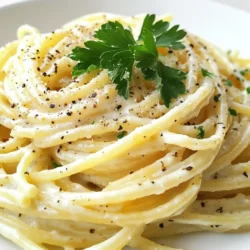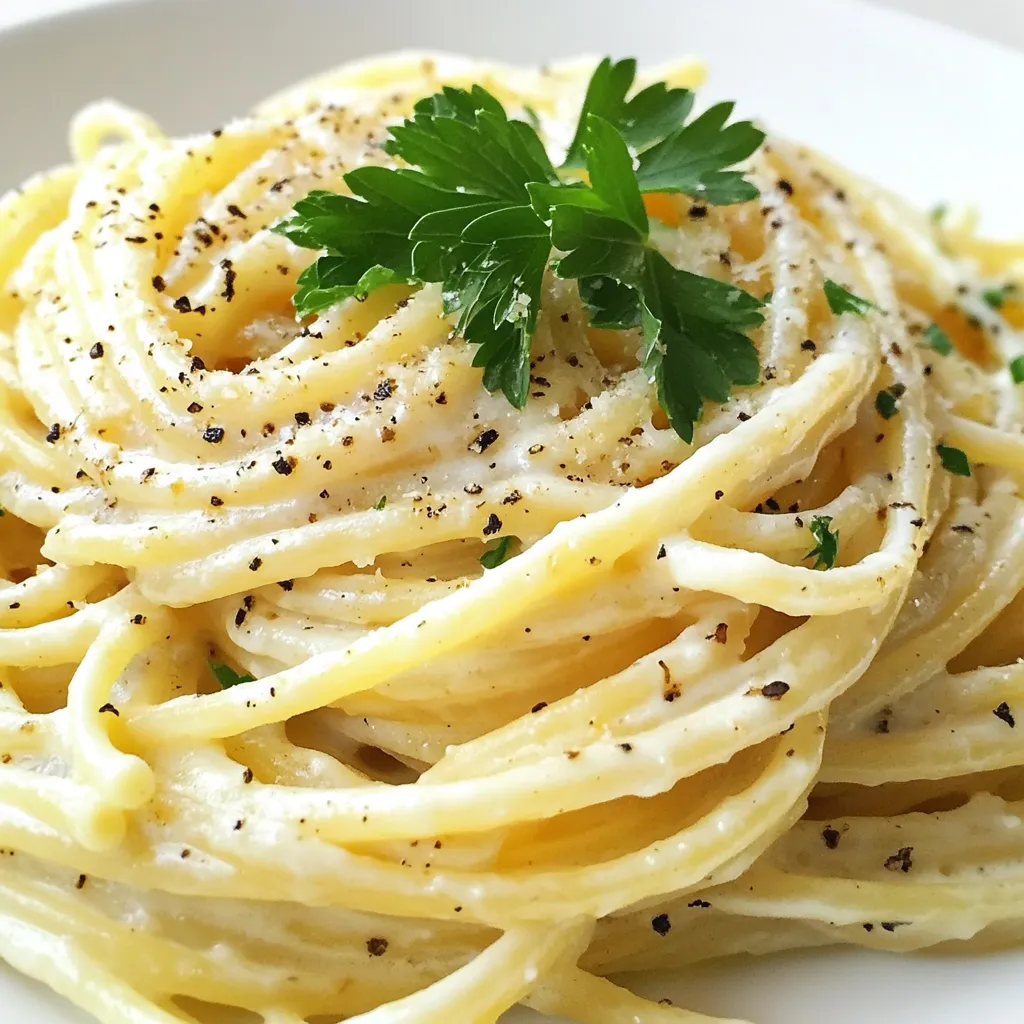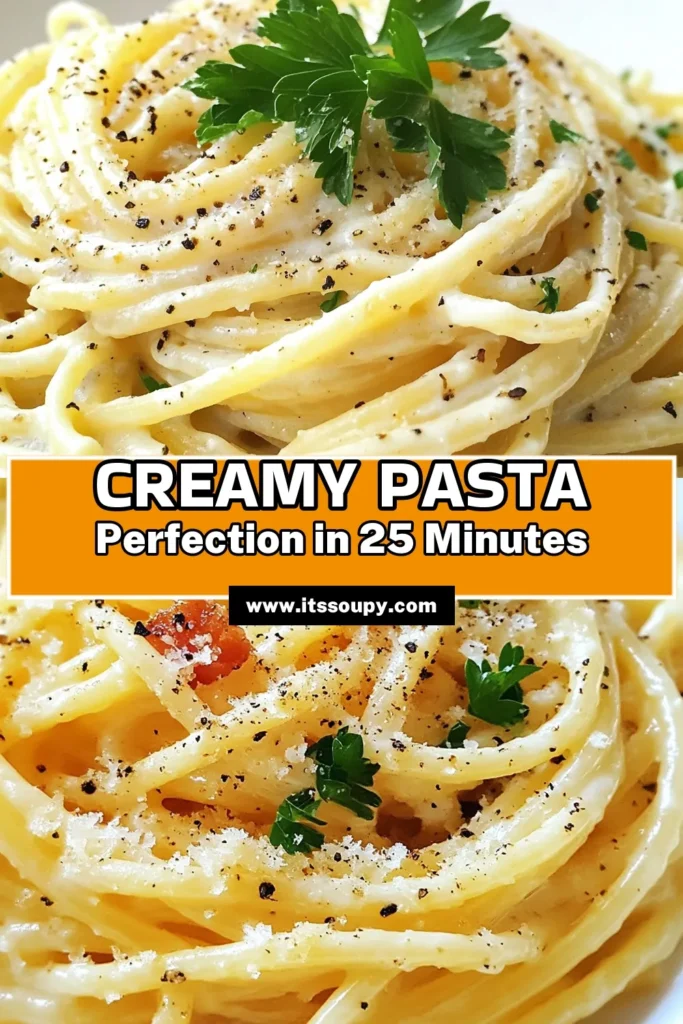Do you love pasta and want to try something new? Let me guide you through making Authentic Spaghetti alla Gricia, a classic dish from Italy. With simple steps and key ingredients, you’ll create a flavorful meal that impresses. I’ll share tips, tricks, and even alternative options for your pantry. Get ready to delight your taste buds with this easy and delicious recipe!
Why I Love This Recipe
- Simple Ingredients: This recipe uses just a handful of ingredients, making it easy to prepare without a long shopping list.
- Quick to Make: With a total time of just 25 minutes, this dish is perfect for a fast weeknight dinner.
- Rich Flavors: The combination of crispy guanciale and creamy Pecorino Romano creates a deeply satisfying flavor profile.
- Customizable: You can easily adjust the seasoning or add ingredients like fresh parsley for a personal touch.
Ingredients
List of Ingredients
To make authentic spaghetti alla Gricia, you need a few key ingredients. Here’s what you will gather:
- 400g spaghetti
- 150g guanciale (or pancetta if unavailable), diced
- 100g Pecorino Romano cheese, grated
- Freshly cracked black pepper
- Salt (for pasta water)
- Optional: Fresh parsley for garnish
Guanciale is the traditional choice here. It’s made from the pig’s cheek or jowl. If you can’t find guanciale, pancetta works as a good substitute. It still gives a nice flavor, though it may be a bit less rich.
When it comes to cheese, Pecorino Romano is a must. This cheese adds a salty and sharp taste. I recommend looking for brands like Fulvi or Sini Fulvi. They are known for their quality. Aim for a cheese that is aged well and has a crumbly texture.
The black pepper is also important. It adds heat and depth to the dish. Use freshly cracked pepper for the best flavor.
Keep in mind, the pasta water is not just for boiling. It helps make your sauce creamy. Don’t forget to reserve some before draining the spaghetti!
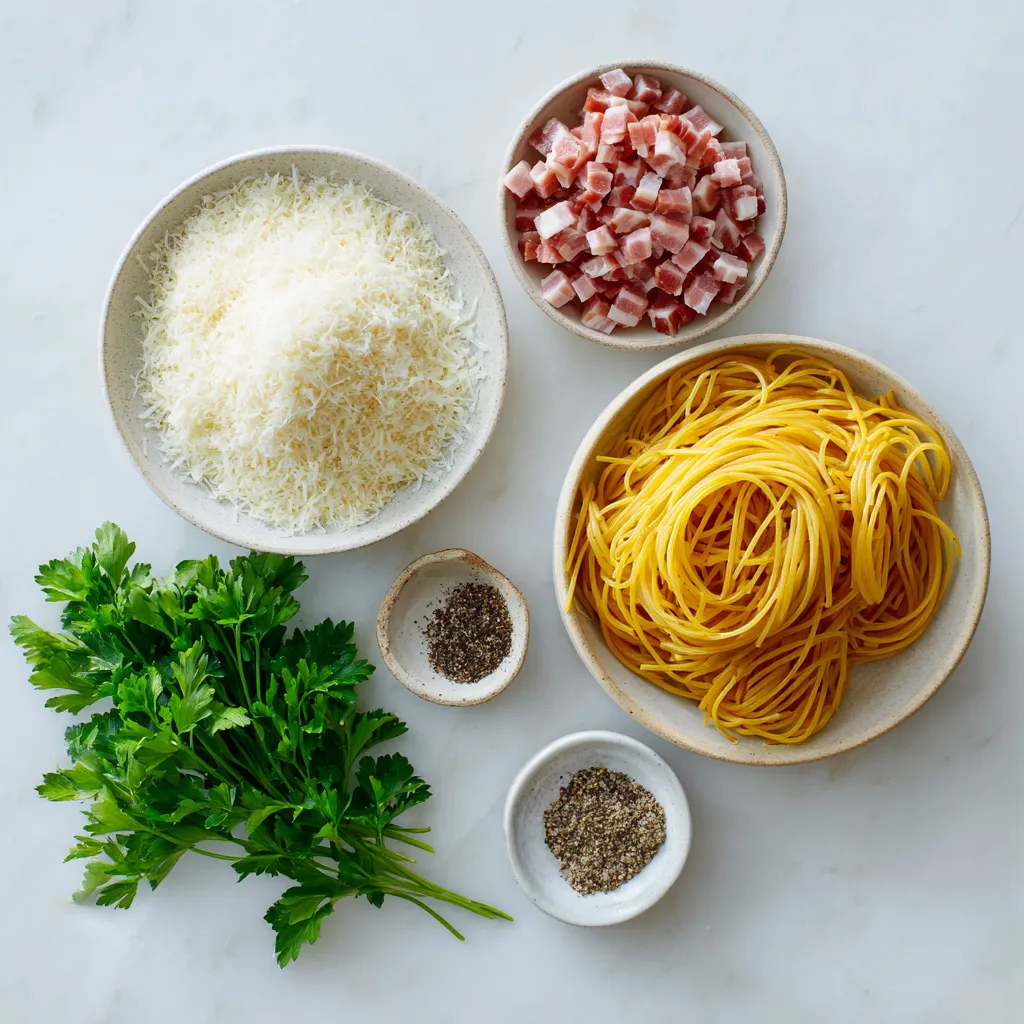
Step-by-Step Instructions
Preparation Process
To cook al dente spaghetti, start with a large pot of salted water. Bring it to a boil. Add 400g of spaghetti. Cook it according to the package instructions. Aim for a firm bite that is not mushy. This usually takes about 8 to 10 minutes.
While the pasta cooks, we focus on the guanciale. Heat a large skillet over medium heat. Add 150g of diced guanciale. Cook it for about 4 to 5 minutes. You want it crispy and golden brown. This fat adds depth to the dish. Be careful not to burn it; we want the fat to render and coat the pasta.
Creating the Sauce
Once your spaghetti is ready, reserve about 1 cup of the pasta water. This water is full of starch and helps bind the sauce. Drain the spaghetti but do not rinse it. Rinsing washes away the starch, making it hard for the sauce to stick.
Add the drained spaghetti to the skillet with the guanciale. Toss the pasta well to coat it in the flavorful fat. Remove the skillet from the heat. Now, sprinkle in 100g of grated Pecorino Romano cheese. Add freshly cracked black pepper to taste. Mix everything vigorously. Slowly add the reserved pasta water, a little at a time. This will create a creamy sauce that clings to the pasta.
Serving Suggestions
For serving, place the pasta on a large plate. Add extra Pecorino Romano on top. A sprinkle of black pepper adds flavor and a nice touch. If you like, garnish with fresh parsley for color. This dish shines when served simply, allowing the flavors to stand out. Enjoy your meal with a side of crusty bread or a light salad for balance.
Tips & Tricks
Achieving Authentic Flavor
Using traditional ingredients is key to great Spaghetti alla Gricia. Guanciale gives a rich taste. If you can’t find guanciale, pancetta works too. The cheese choice matters as well. Pecorino Romano is the best for its salty, sharp flavor.
Black pepper is a must-have spice. Freshly cracked black pepper adds warmth and depth. It enhances the dish’s taste and makes it special. You want to use a good amount, so don’t hold back!
Common Mistakes to Avoid
Overcooking pasta can ruin your dish. Aim for al dente, which means firm yet tender. Check the pasta a minute before the package time. It should have a slight bite.
Guanciale can burn easily if you’re not careful. Cook it over medium heat and watch it closely. You want it crispy but not burnt. If it cooks too fast, turn down the heat. This way, you keep all that lovely flavor without any bitterness.
Pro Tips
- Use Quality Ingredients: The flavor of this dish heavily relies on the quality of the guanciale and Pecorino Romano. Opt for authentic ingredients for the best taste.
- Control the Heat: When cooking the guanciale, keep an eye on the heat to avoid burning. You want it crispy but not charred.
- Starch is Key: Do not rinse the pasta after draining. The starch on the spaghetti helps the sauce adhere and creates a creamy texture.
- Adjusting Sauce Consistency: Use the reserved pasta water gradually. This allows you to control the creaminess of the sauce to your preference.
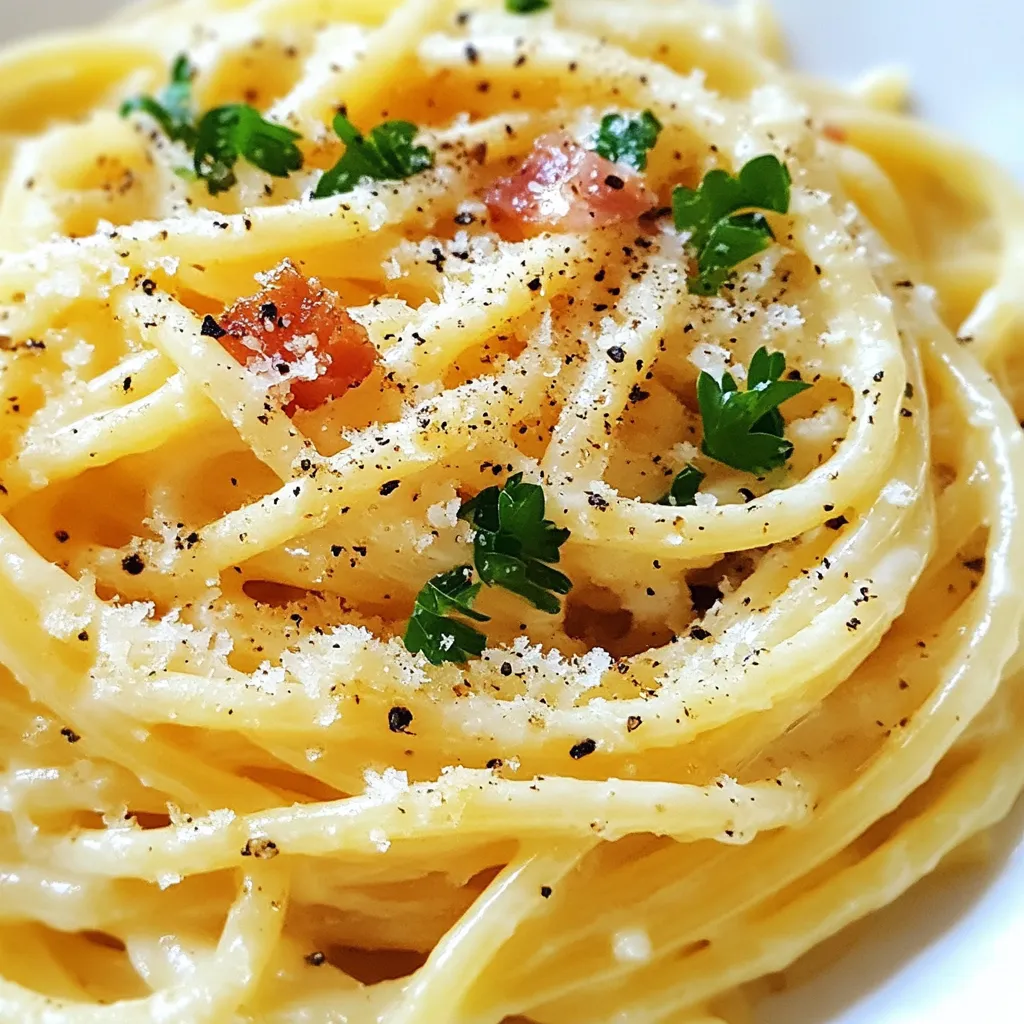
Variations
Regional Differences
Spaghetti alla Gricia has roots in the Lazio region of Italy. Each area puts its twist on this classic dish. In Rome, they use guanciale, a pork cheek, for its rich flavor. In other regions, like Umbria, cooks might use pancetta instead. This small change can change the taste and texture.
Different areas also have unique ways of preparing the dish. In some places, they add garlic or onion. Others prefer to keep it simple. The key is to stick to the core ingredients: pasta, guanciale, and cheese. This keeps the dish true to its origin.
Ingredient Swaps
If you want a vegetarian version, you can swap guanciale for mushrooms. They give a nice umami flavor. Smoked tofu is another good choice that adds texture and taste. For gluten-free options, use gluten-free pasta. It cooks well and holds the sauce nicely.
When making these swaps, remember to keep the cooking method the same. Aim for that creamy sauce by using pasta water, just as you would in the classic recipe. This makes sure your dish remains rich and flavorful.
Storage Info
Storing Leftovers
To store your spaghetti alla Gricia, cool the dish first. Place leftovers in an airtight container. Refrigerate them within two hours of cooking. They stay fresh for up to three days. You can also freeze it for up to three months. To freeze, use a freezer-safe container. Make sure to leave space for expansion.
When reheating, use a skillet over low heat. Add a splash of water or olive oil. This helps keep the pasta moist. Stir gently until warmed through. Avoid the microwave if you can, as it can dry out the pasta.
Shelf Life Guidelines
Spaghetti alla Gricia lasts about three days in the fridge. After that, it may lose its quality. If you freeze it, label the container with the date. This helps you track how long it’s been stored.
To ensure food safety, always check for signs of spoilage. If the pasta smells off or looks strange, it’s best to toss it. Proper storage helps you enjoy this dish at its best.
FAQs
What is the history of Spaghetti alla Gricia?
Spaghetti alla Gricia comes from the Lazio region in Italy. It is named after the town of Gricia. This dish dates back to the 18th century. It is simple, yet full of flavor. Originally, shepherds made it using local ingredients. They cooked it while tending to their sheep in the hills.
The dish uses few ingredients: guanciale, pasta, cheese, and pepper. Each one plays an important role. The guanciale adds richness. The Pecorino Romano cheese gives it a salty bite. Black pepper brings warmth and depth. Together, these flavors create a dish that is both comforting and satisfying.
Spaghetti alla Gricia holds a special spot in Roman cuisine. It is often called the “father of all pasta dishes.” Many consider it a predecessor to other famous dishes like Carbonara and Amatriciana. This history shows how simple meals can have deep roots.
Can I use other types of cheese?
Yes, you can use other cheeses, but they change the flavor. Pecorino Romano is the traditional choice. It adds a sharp, salty taste that pairs well with guanciale. If you cannot find it, try Parmigiano-Reggiano. It is milder and nutty but still tasty.
Another option is Grana Padano. It has a similar texture to Pecorino but is less salty. If you want a creamier feel, consider using a soft cheese like ricotta. Just remember, using a different cheese will shift the dish’s traditional taste.
How do I make Spaghetti alla Gricia vegan?
To make Spaghetti alla Gricia vegan, you need to swap out the main ingredients. First, replace guanciale with a plant-based alternative. You can use diced mushrooms or smoked tofu for a similar texture.
Next, use a vegan cheese. Nutritional yeast gives a cheesy flavor without dairy. You can also find store-bought vegan cheeses that melt well.
Here’s a simple way to make it vegan:
1. Cook your spaghetti in salted water until al dente.
2. Sauté mushrooms or tofu in a pan until crispy.
3. Toss the pasta with the sautéed vegan option.
4. Stir in nutritional yeast and black pepper to taste.
5. Serve hot, and enjoy your plant-based dish!
This way, you can enjoy the flavors of Spaghetti alla Gricia while keeping it vegan.
This blog post highlighted the key ingredients, steps, and tips for making Spaghetti alla Gricia. We covered the importance of traditional flavors, proper cooking techniques, and ingredient swaps for dietary needs. Remember, using the right ingredients, like guanciale and Pecorino Romano, makes all the difference. Avoid common cooking mistakes for the best results. Whether you serve it traditionally or adapt it, enjoy your dish! Cook with care, and your love for this pasta will shine throug
